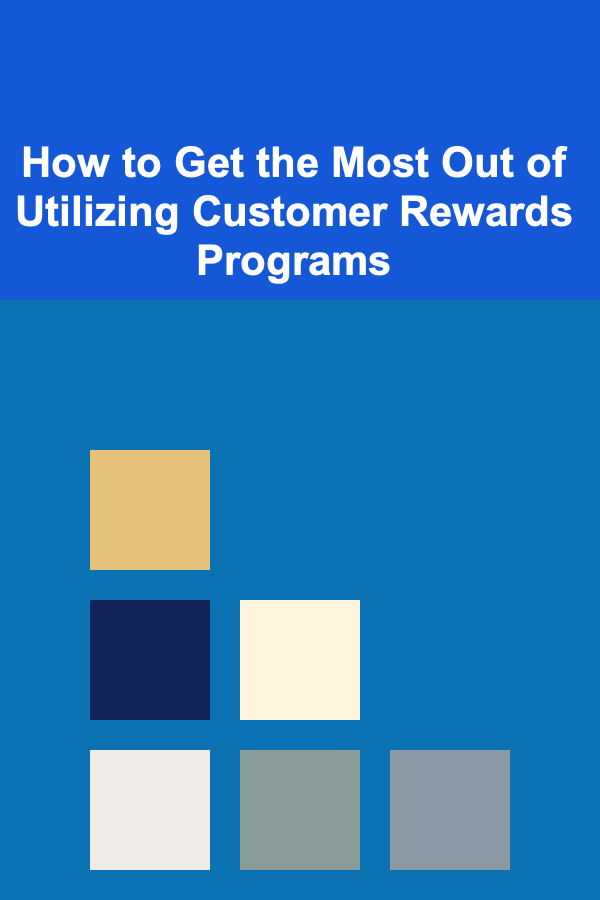
How to Get the Most Out of Utilizing Customer Rewards Programs
ebook include PDF & Audio bundle (Micro Guide)
$12.99$9.99
Limited Time Offer! Order within the next:

Customer rewards programs have become a cornerstone for building loyalty and driving long-term engagement with consumers. When properly executed, these programs can enhance customer satisfaction, increase repeat business, and boost brand advocacy. But to unlock their full potential, businesses must go beyond simply offering discounts or points -- they need to design thoughtful, effective, and personalized experiences that make customers feel truly valued.
This actionable guide provides in-depth strategies for businesses seeking to get the most out of their customer rewards programs. Whether you're just launching one or looking to optimize an existing program, these insights will help you create a rewards system that delivers measurable benefits both to your customers and your business.
Understand Your Customer Segments
One of the first steps in creating a successful rewards program is to deeply understand your customers. Not all customers are motivated by the same incentives, and recognizing this can help you design a program that speaks to the unique needs and preferences of different segments.
Identify Key Customer Segments
- Frequent Shoppers: These customers make purchases regularly. For them, an effective reward might include early access to sales, special discounts, or tiered loyalty points.
- High-Value Shoppers: These customers spend more per transaction. Consider offering rewards that align with the premium experience they expect, such as exclusive services, high-end products, or personalized offers.
- Occasional Shoppers: These customers may not make purchases often but can be encouraged to buy more if they see a significant reward. A points-based system or a limited-time offer could reignite their interest.
- New Customers: Attracting new customers to your rewards program requires offering an immediate incentive that draws them in, such as a welcome bonus or a discount on their next purchase.
Tailor Rewards for Each Segment
Rather than offering the same rewards to every customer, create personalized experiences that cater to the motivations of different segments. For example, loyal, frequent customers might appreciate earning points that lead to discounts, while high-value customers could benefit more from personalized offers or invitations to exclusive events.
Design an Intuitive and Accessible Rewards System
The structure and accessibility of your rewards program can significantly influence how successful it is. A complicated or hard-to-navigate system can deter customers from engaging with the program altogether. The key is to ensure that the system is simple, intuitive, and easy to use.
Simple Earning and Redemption Process
Ensure that customers can easily understand how they earn points or rewards and how to redeem them. For instance:
- Clear Points System: If customers earn points for every dollar spent, clearly communicate the points-to-currency ratio.
- Easy Redemption: Allow customers to redeem rewards both online and in-store, making the process seamless regardless of how they shop.
Create Tiered Rewards
A tiered rewards system encourages more frequent engagement. By rewarding customers with greater benefits as they move up the tiers, you create a sense of achievement and incentivize them to spend more to unlock higher rewards. Tiers can be based on factors like:
- Annual spend: Customers who spend more receive better rewards.
- Frequency of purchases: Those who purchase often may move to higher levels.
- Customer lifetime value: Loyal customers who have been with your brand for a long time might be rewarded with VIP status.
Mobile Access and Integration
With many customers interacting with businesses through their mobile devices, it's essential to offer a mobile-friendly experience. This could involve:
- A rewards app that lets customers check their points balance, earn rewards, and redeem offers.
- Integrating your rewards program with your brand's mobile wallet (like Apple Wallet or Google Pay) to make it even more convenient.
Offer Meaningful and Attractive Rewards
The effectiveness of your rewards program hinges on offering incentives that are valuable to your customers. The rewards should feel substantial and tailored to the preferences of your target audience. Here are some options for meaningful rewards:
Discount and Coupons
Offering discounts or coupons is the most common and straightforward reward. However, make sure that the discount feels like a valuable benefit. A 10% discount might not feel like much, but a 30% off coupon on a customer's next purchase could feel like a more substantial reward.
Exclusive Experiences and Products
Rather than focusing solely on discounts, consider offering unique experiences or exclusive products that customers cannot get elsewhere. For example:
- VIP events: Invitations to private sales, early access to new products, or special events.
- Exclusive products: Limited edition products only available to top-tier members.
- Personalized services: Personalized product recommendations, free consultations, or tailored offerings.
Charitable Donations
Some customers are more motivated by contributing to causes they care about. Offer the option to donate rewards points to charity. This option appeals particularly to socially conscious consumers.
Experiential Rewards
Experiential rewards, such as free shipping, upgrades, or exclusive access to services (e.g., personal shoppers or priority customer service), can enhance the customer experience in ways that discounts simply can't.
Leverage Data to Personalize Rewards
A one-size-fits-all approach to rewards can be ineffective, as customers have different preferences and spending habits. Data plays a crucial role in personalizing rewards, making customers feel seen and understood.
Utilize Purchase History and Preferences
Leverage data about customers' purchase history to offer tailored rewards that align with their tastes and habits. For instance, if a customer regularly buys outdoor gear, offer them a reward that reflects that interest, such as a discount on related products.
Personalize Communication
Use the information you've gathered about your customers to send personalized offers. Rather than sending blanket email promotions, tailor them based on what the customer has previously purchased or their reward status. Personalized emails are more likely to resonate with the recipient, leading to higher engagement and redemption rates.
Predict Future Behavior
By analyzing patterns in customer behavior, you can predict which rewards might appeal to them in the future. For example, if a customer tends to buy more during the holiday season, offer them a special reward ahead of time to encourage them to shop early.
Encourage Referrals and Social Sharing
Referral programs can be an excellent way to increase your customer base while rewarding existing customers. When you make it easy and worthwhile for customers to refer others, you can harness the power of word-of-mouth marketing.
Offer Referral Bonuses
Incentivize your loyal customers to refer their friends and family to your business by offering them rewards for every successful referral. These could include points, discounts, or even exclusive items.
Social Media Engagement
Encourage customers to share their rewards experience on social media by offering additional rewards for posts or sharing. You could create branded hashtags, run social media contests, or offer points for tagging the brand in posts related to their rewards experience.
Maintain Transparency and Communication
To keep customers engaged with your rewards program, it's important to maintain transparency and open communication. Customers should always know where they stand in terms of points, how close they are to earning rewards, and what rewards are available.
Regular Updates
Send regular updates to customers about their points balance, available rewards, and new opportunities to earn points. Use email, SMS, or push notifications to keep customers informed and motivated.
Clear Terms and Conditions
Ensure that the terms and conditions of your rewards program are clear and easy to understand. Hidden fees, complicated redemption rules, or expiration dates that aren't clearly communicated can frustrate customers and make them less likely to continue participating.
Provide Outstanding Customer Support
Ensure that your customer service team is trained to handle any issues related to the rewards program. A customer who has difficulty redeeming rewards or has a bad experience may not return, so excellent service is essential for maintaining loyalty.
Monitor Performance and Optimize Your Program
To ensure your rewards program remains effective, regularly monitor its performance and optimize it based on customer feedback and business results. You can track key metrics such as:
- Redemption rates: How often customers redeem rewards.
- Engagement levels: How frequently customers engage with your program.
- Customer retention: Are customers who participate in the rewards program more likely to stay loyal to your brand?
Make Adjustments Based on Feedback
Constantly gather customer feedback about their experience with the program. Are the rewards appealing? Is the program easy to use? What improvements could be made? Use this feedback to refine your rewards program to better meet your customers' needs.
A/B Testing
Regularly test different rewards, communications, and incentives to see what works best. For instance, try offering a smaller, more frequent reward versus a larger, less frequent one and see which generates higher engagement.
Conclusion
A customer rewards program can be a powerful tool for fostering loyalty, increasing engagement, and driving long-term success. However, to maximize its impact, businesses must take a strategic approach, focusing on personalization, simplicity, and value. By understanding your customers, offering attractive rewards, and continuously optimizing the program based on data, you can create a rewards experience that not only delights your customers but also strengthens your business.

How to Communicate Effectively with Tenants
Read More
How to Create an Online Course for Aspiring Video Producers
Read More
How to Plan Your Website's Structure: A Checklist for Clear Navigation
Read More
How to Set Boundaries to Protect Your Time
Read More
One-Page Website vs. Multi-Page Website: Which Is Right for You?
Read More
How to Discuss a Film's Opening and Closing Scenes
Read MoreOther Products

How to Communicate Effectively with Tenants
Read More
How to Create an Online Course for Aspiring Video Producers
Read More
How to Plan Your Website's Structure: A Checklist for Clear Navigation
Read More
How to Set Boundaries to Protect Your Time
Read More
One-Page Website vs. Multi-Page Website: Which Is Right for You?
Read More